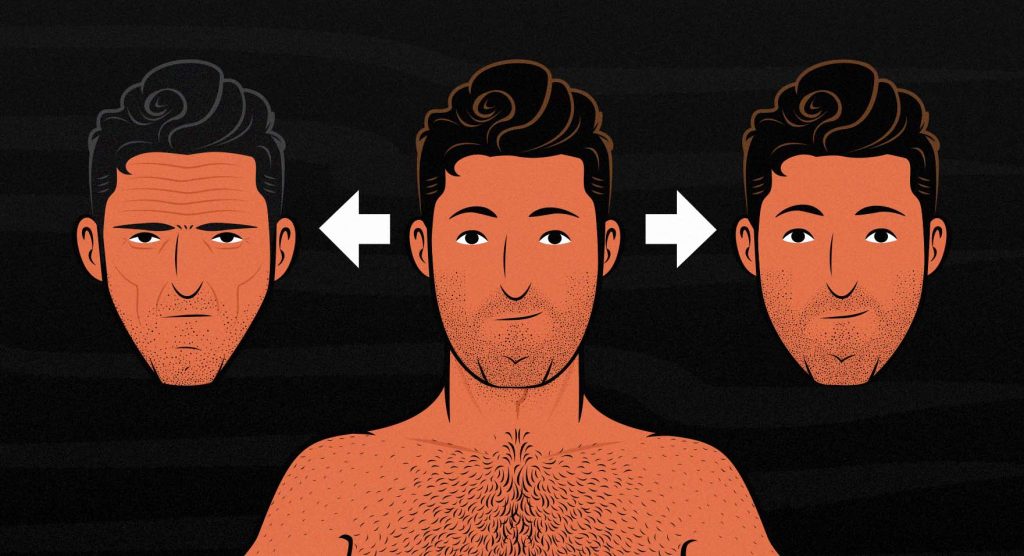
Is Cutting Healthy? The Hidden Harms and Benefits of Fat Loss
A couple of months ago, I noticed my lifting belt was getting a bit tight. I wanted to lose that extra bit of fat, but I didn’t want to go on a long cut. So, I decided to do a quick “mini-cut,” going into a deep calorie deficit for a few weeks.
It worked. I lost 12 pounds, going from 200 down to 188 pounds, and bringing my waist size from 34 inches down to 31 inches. Then I reinflated a little bit over the next couple of weeks, leaving me at 192 pounds, still just as strong as when I started.
But the huge calorie deficit felt unhealthy. I felt anxious and tired. And my middle-aged vanity started attacking me from angles I wasn’t used to. I started wondering if it would affect my hair, skin, and face. I worried I might be flirting with health risks.
So, I brushed up on my fat-loss research, and I discovered some interesting things.
The Olly Murs Controversy
The Before/After Photos
A couple of months ago, I started getting notifications that my Most Attractive Male Body article was being linked to by a few dating blogs. These blogs were talking about how Olly Murs, an English pop singer, was less attractive to women after losing fat.
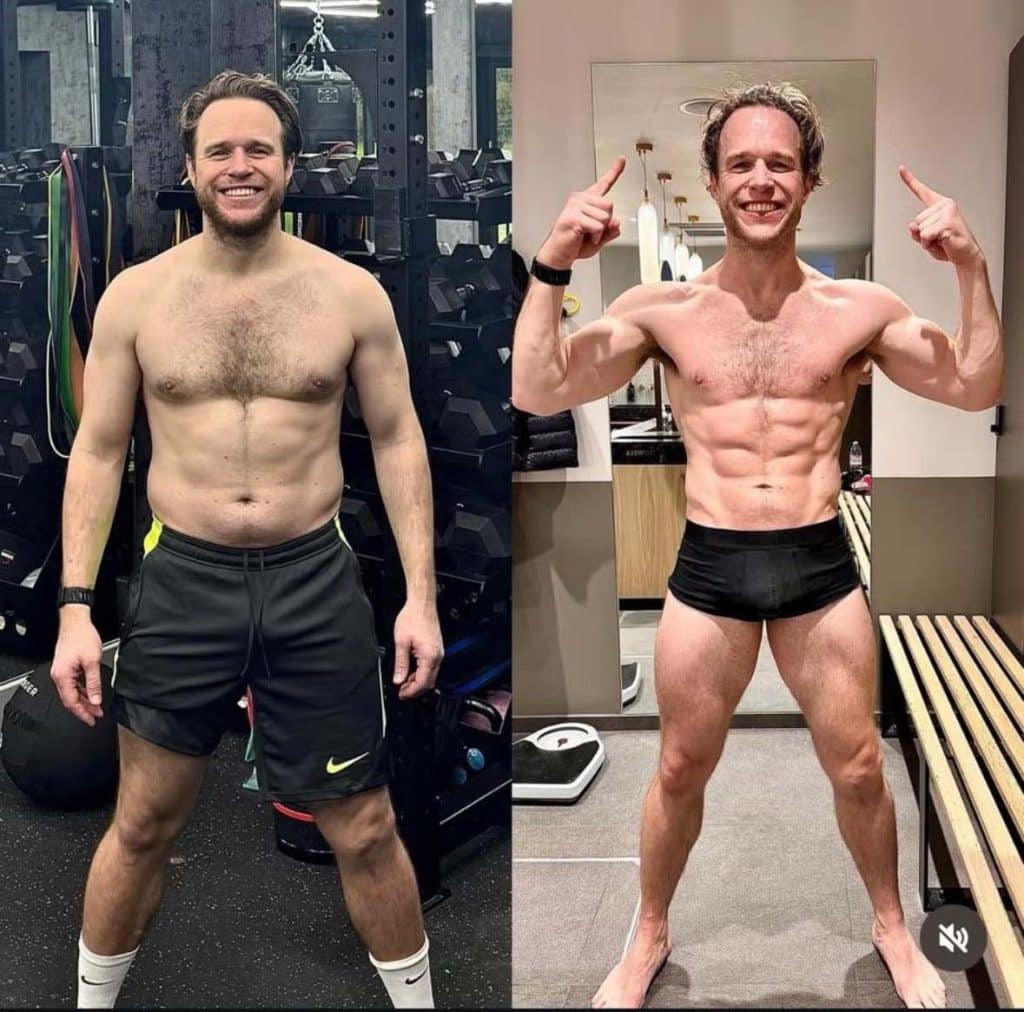
Olly Murs was stoked about his progress, as he should be, so he posted his transformation online. William Costello, a researcher who studies incels, reposted the image, asking his audience whether they preferred the Before photo or the After photo.
It turns out most men preferred the After photo, as you’d expect, whereas most women preferred the Before photo.
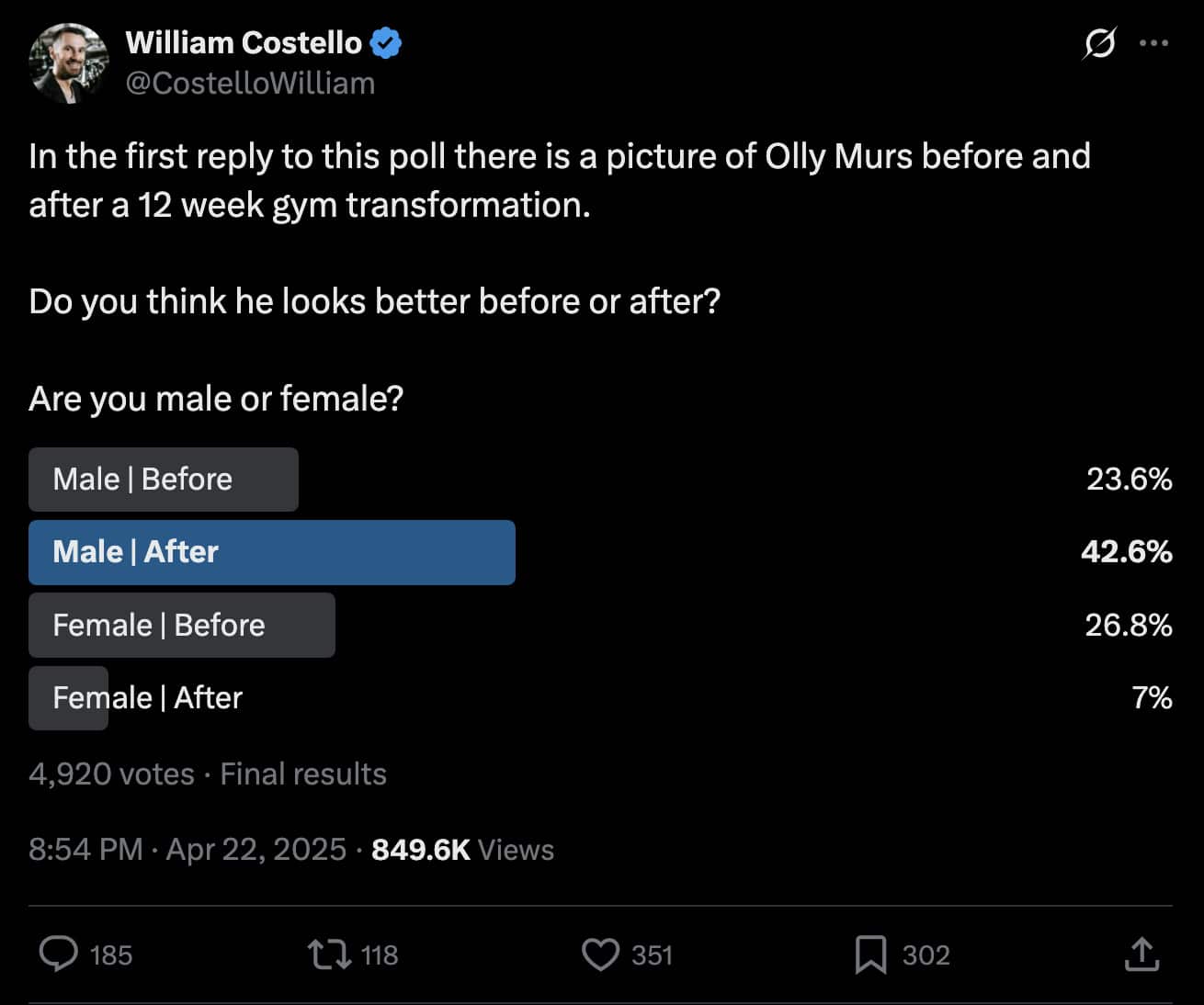
This sparked a huge argument, with men accusing women of lying about what they find attractive, and then women accusing men of being idiots for not understanding what they find attractive. That’s why I was getting all of these notifications. Bloggers were linking my survey results to prove their point.
Do Women Really Prefer Dad Bods?
It isn’t that surprising that women found Olly Murs more attractive before he lost weight. Men care more about muscle and leanness than women do. Most women aren’t looking for bodybuilders; they’re looking for guys who are strong, athletic, fit, healthy, and capable (more on that here).
It’s sort of like how if you had a Hollywood actress lose 30 pounds, giving her more of a high-fashion runway look, most women would think she looks better, whereas most men would prefer the look of the healthier, more feminine figure she had before (reference, explanation).
So, no surprise that getting super chiselled doesn’t hit as hard with women as it does with men. Especially because Olly Murs already looked reasonably strong, healthy, and athletic in his Before photo.
There’s something else going on here, though. He looks stronger, leaner, and more athletic in his After photo, but take a look at his face:
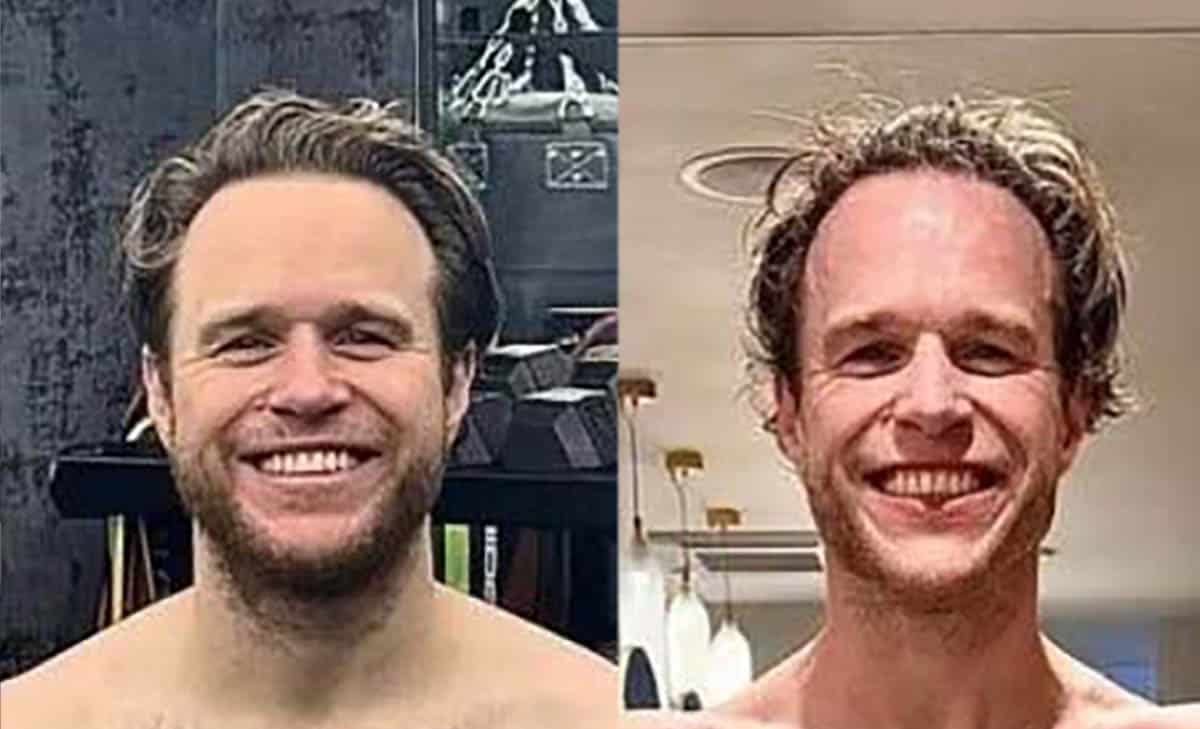
Something looks off in the after photo. While guys were admiring Olly’s abs, I’m guessing women were looking at his face and noticing a less favourable change.
It might just be the photo. Maybe it’s the downward lighting, with his nose casting that harsh shadow on his lip. Maybe it’s a poor night’s sleep or a bad hair day. But he looks less healthy after spending all of this time trying to get into better shape.
If we look at other photos from different periods, he’s lean in a way that looks healthy, making him look better in every way:

Some women still might not like the After photo. He might look a little too posed, a little too vain. Most women don’t like it when men behave like peacocks, spraying themselves with an artificial tan, oiling up, and flexing for a photo.
You could argue that even just having chiselled abs can give off that vibe. Women prefer a dad bod—a man with some meat on him. And many women said exactly that, complaining that he looked like the sort of guy who wouldn’t be fun to go on a dinner date with.
But again, that’s not so much his body, more the way he’s presenting it. In a shirt, without all the preening and flexing, he would look like a strong, fit, healthy, and athletic guy. It’s a great physique. It’s about as close to ideal as you can get.
It only looks overly contrived because it is—he’s posing for a physique photoshoot. And that’s perfectly fine. It wasn’t his Tinder profile picture. It was never supposed to make him seem more attractive. It was designed to show off his transformation (which was awesome).
Ozempic Face
I don’t know Olly Murs. I’m not trying to guess at what made the difference. But as this controversy was going on, the Ozempic transformations were rolling in, and people were noticing how some of those After photos were making people look older and frailer.
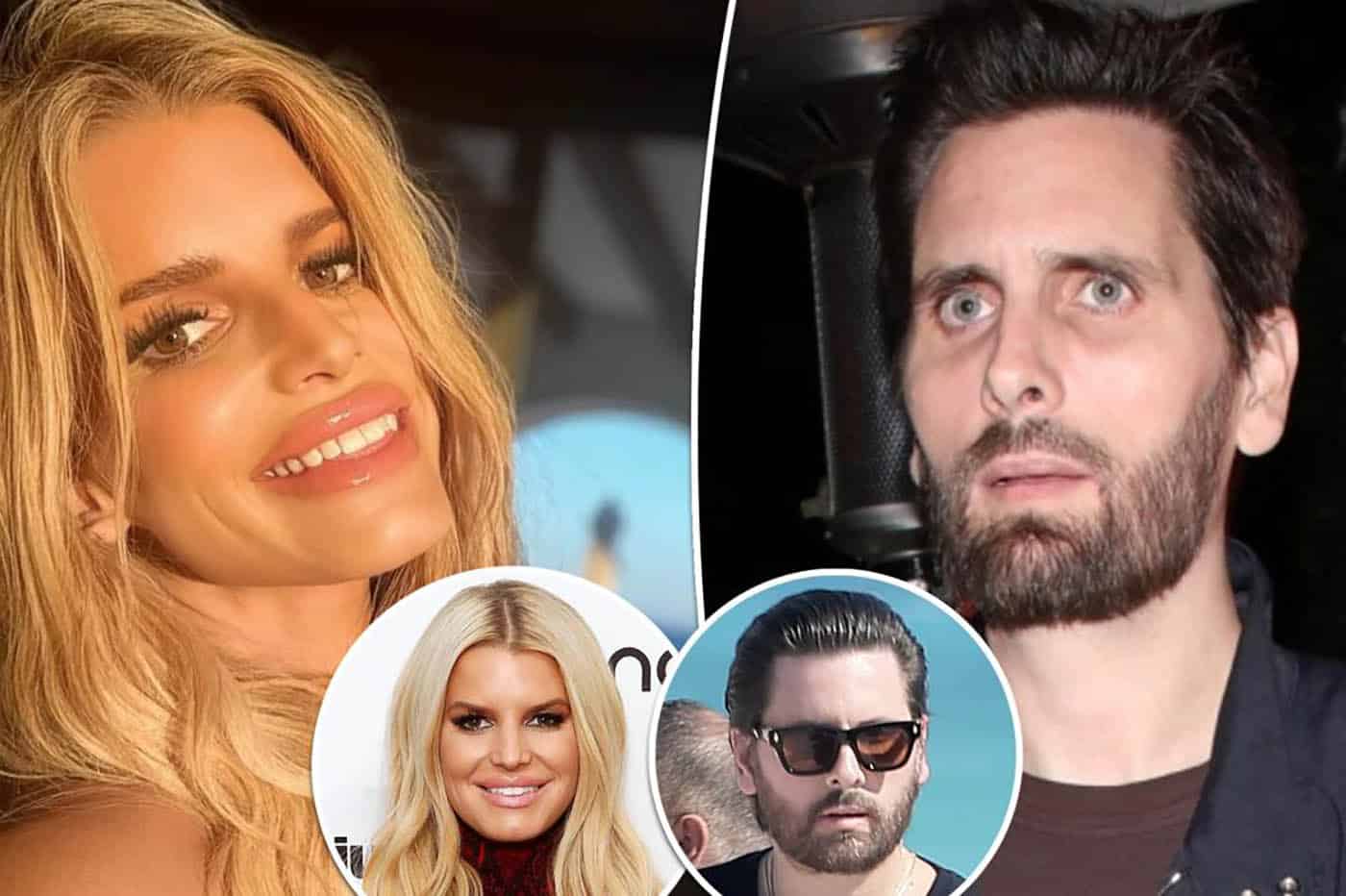
Why would Ozempic affect people like that? Is semaglutide bad for our health?
I’m a strength and fitness coach, not a doctor. I don’t have any special insight into the health effects of Ozempic. I’m here to help you use exercise, nutrition, and lifestyle to help you get stronger, fitter, healthier, and better looking. If your doctor recommends Ozempic, we can work with that. If you want to do this naturally, we can work with that, too.
So let’s put Ozempic aside and look at exercise, nutrition, and lifestyle. When we do that, in addition to whatever other side effects Ozempic is having (or not having), it’s clear that what we’re seeing is a new wave of crash diets.
Crash Diets
A crash diet is when you drastically reduce your calorie intake, usually without much focus on exercise or diet quality. The idea is just to lose weight as quickly as possible.
In the past, plenty of people tried to follow crash diets. Some succeeded, too. There are stories of people surviving on just carrot juice, or potatoes, or eating only McDonald’s.
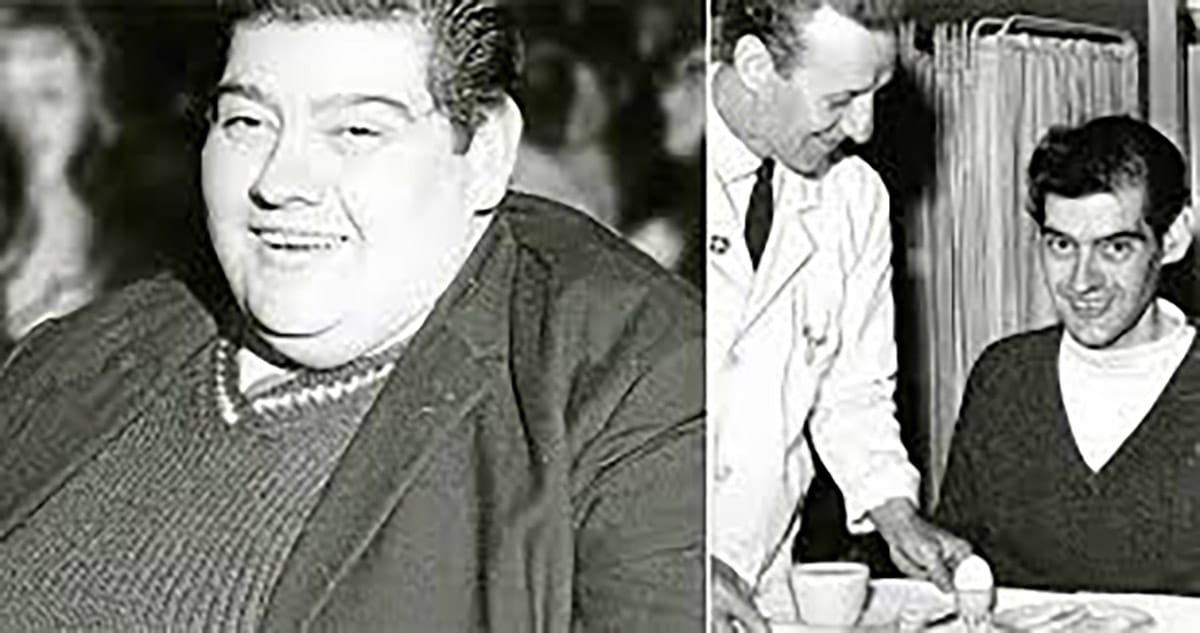
There was even an Irish guy, Angus Barbieri, who fasted for a full year. He had so much body fat that he didn’t need to eat any food at all. All he consumed was coffee, tea, sparkling water, vitamins, and yeast extract for a full year, losing 276 pounds, going from 456 to 180 pounds.
The Problem With Crash Diets
But the first problem with crash diets is that they’re brutally hard, especially when you start getting relatively lean. Cutting from 290 pounds to 280 pounds isn’t the same as cutting from an athletic 180 pounds down to a chiselled 170 pounds. The leaner you get, the more your body fights back.
Olly Murs wasn’t 400 pounds. He was trying to go from being slightly overweight to having an athletic physique. Same thing with these other celebrities. Same with most of our clients.
The second problem is that crash diets are notorious for causing nutrient insufficiencies and deficiencies. An insufficiency is when you don’t have enough nutrients to be healthy. A deficiency is when you have so few nutrients that you get a disease. When people diet, they eat less food, bringing in fewer nutrients.
For example, an athletic man can benefit from up to about 200 mg of vitamin C per day. Getting fewer than 90 mg is unhealthy (insufficiency). And if you fall way below that, you can get scurvy (from a deficiency). Almost nobody gets scurvy these days, but most people aren’t getting 90 mg, let alone 200.
The third problem is that eating fewer calories can make you feel stressed and lethargic. It’s hard to find the energy to exercise, hard to keep your stress hormones under control, and hard to sleep well at night.
Combine all three of these factors together, and it’s incredibly hard—maybe even impossible—to crash diet in a healthy way, especially if you do it for more than a few weeks in a row.
The Bodybuilder “Death Face”
Ozempic makes it unpleasant to eat, making it easy for people to lose weight quickly, without really needing to learn very much about nutrition or exercise. Even if the drug itself is perfectly healthy, people may still do too little exercise, eat too little food, and lose weight too quickly. It can throw people into an accidental crash diet.
One of the problems with being too thin is that it can make us look gaunt, sick, and fragile. I’m a naturally skinny guy, and I spent quite a few years that way, getting concerned comments from everyone I knew. It drove me crazy.
When I started lifting weights and bulking up, my face filled in, and I started looking much better. All of those negative comments went away. I also started noticing how natural bodybuilders were making their faces gaunt on purpose. They called it the “death face.”
There’s a similar trend of looksmaxxing teens trying to chisel out their faces beyond the point where it looks healthy. The guys want a chiselled jaw. The women want hollow cheeks.
We have fat on top of our muscles, hiding our muscle definition. And we have fat underneath our abs, interfering with organ function. But we also have fat in our faces, and that facial fat serves as insulation, cushioning, and lubrication, allowing our muscles to glide smoothly as we chew and make facial expressions. Having a moderate amount of facial fat also makes us look youthful and healthy.
And when we crash diet, we don’t just lose fat, we pull energy from everywhere, including muscle, organ, and bone. We lose the muscle in our faces, too. Those weaker muscles give us weaker facial expressions. The changes show up in our hair, nails, eyes, and biceps. It can appear like we’re wasting away from disease.
Hollywood Body Transformations
This isn’t just an Ozempic thing, and it’s not just Olly Murs. We’ve been seeing celebrity crash diets for decades. Christian Bale was famous for it twenty years ago:

I’m a naturally skinny guy. When I was first getting into lifting, I was underweight, with a BMI of 16–17. I looked like the Machinist, and I found it inspiring to see how Christian Bale bulked up for Batman Begins.
I knew it wasn’t quite the same. I knew he had dieted down on purpose. I knew it had been hard for him to get down to my weight, but also much easier for him to bulk back up. But I thought that maybe my face would have that same transformation. And it did.
How to Diet the Healthy Way
Being Lean is Incredibly Healthy
When done properly, fat loss can be extremely healthy, and not just in the obvious ways. In fact, getting down to a healthy body fat percentage is so profoundly healthy that most people’s health markers improve even when they’re following extreme, nutrient-insufficient crash diets. They get the many downsides, yes, but those downsides still tend to come with health benefits, often resulting in overall health improvements.
That’s why doctors sometimes recommend drastic fat-loss methods like bariatric surgery and expensive drug regimens. If someone isn’t willing or able to lose fat with diet and exercise (which isn’t a doctor’s specialty anyway), they need to find another way. There are downsides to these more extreme approaches, absolutely, but those downsides need to be weighed against the profound health benefits of fat loss.
If someone weighs 400 pounds and hasn’t had success losing fat any other way, drastic measures start to make sense. But you probably don’t weigh 400 pounds. If you’re here on this blog, you’re probably the sort of person interested in diet, exercise, and lifestyle. You’re probably someone who can lose fat in a totally healthy, sustainable way, reaping the rewards without suffering the downsides.
If you’re naturally skinny or skinny fat, then getting and staying lean is even easier. You’ll probably be comfortable and healthy at a lower weight and body fat percentage.
Also, even if you lose fat in an unhealthy way, you can recover. You’ll notice that Christian Bale has hollowed himself out and then gotten back into great shape. I spent many years being gaunt and then found a way to bulk up. People who crash diet can start eating a good diet and living a healthy lifestyle.
The Benefits of Burning Excess Body Fat
To understand the benefits of being lean, we need to understand the downsides of being fat. When your body fat percentage drifts too high, your fat cells get too big. They become stressed and stop working properly. The fat tissue fills with immune cells that cause inflammation, blood vessels health degrades, and scar-like fibrosis develops. This leads to problems like insulin resistance, high blood sugar, and heart disease (study).
- Fat loss is like a lion picking off the weakest gazelles and consuming them, leaving a stronger herd. Old fat cells can become “senescent,” which means they stop dividing properly and start pumping out harmful inflammatory signals. When you lose fat, your body gets rid of these dysfunctional fat cells first, hunting them down and consuming them for energy.
- When you lose fat, your body regains its vitality. Your fat tissue becomes better at processing and storing energy, inflammation goes down, internal scars heal, and blood flow improves.
- Your fat cells become more “flexible.” Obesity makes fat cells worse at switching between storing and burning fat (metabolic inflexibility). Weight loss restores their ability to both store and burn fat efficiently, helping to keep their blood sugar and cholesterol in check.
If you eat well, exercise, and live a healthy lifestyle, and you combine that with a modest (or even fairly aggressive) calorie deficit, you can lose fat in a way that makes you dramatically healthier.
As you trim back your calories, you may need to increase the quality of your diet. If you do it right, you might even be able to get more nutrients out of your fat-loss diet. More protein, vitamins, minerals, fibre, probiotics, omega 3s, polyphenols and all the other micronutrients found in regular, everyday whole foods. To do that, you need to eat nutritious foods, and you also need to eat a good mix of them—a “balanced” diet.
The Ideal Waist Circumference
You’ll know you’re lean enough when your waist circumference is half your height or less (study, study). If you compare the lifespan between people with a healthy waist size against those with the largest waist size, there’s a difference of decades:
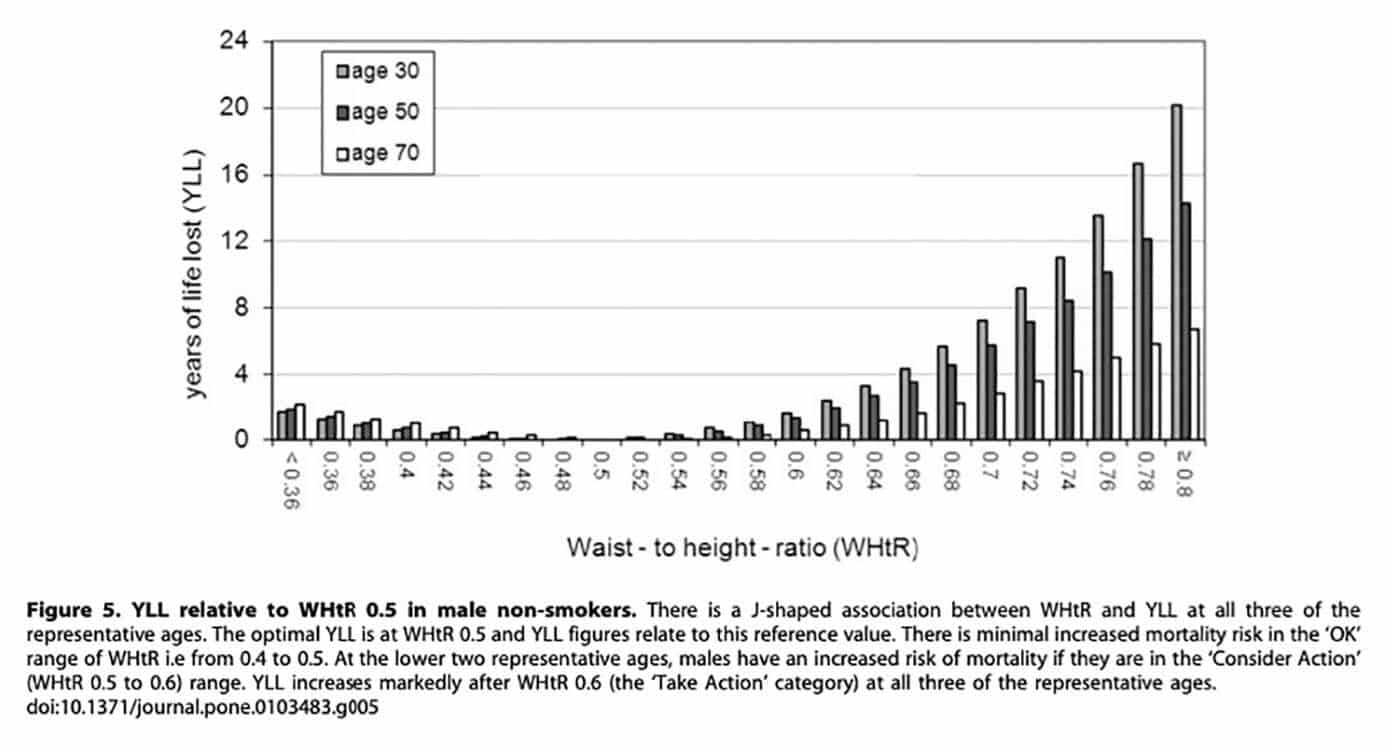
You can cut deeper if you want, chiselling out your abs. But the leaner you get, the slower you should go, and the more important it becomes to eat a great diet and live a healthy lifestyle.
What’s cool about both hypertrophy training and cardio is that they cause you to burn proportionally more visceral fat. That means your waist will shrink faster, you’ll get more health benefits, and you’ll keep more fat in the places you want to keep it. You can have a lean waist with a youthful face, rather than the opposite.

If you have a healthy body fat percentage, you’re already doing great. You already go through periods of slight overeating and slight undereating. That helps your body take care of itself.
Healthy Cutting Guidelines
There are a few things you can do to make fat loss much healthier, and it will come with the bonus of giving you more energy, burning proportionally more fat (versus muscle), burning proportionally more visceral fat (versus subcutaneous fat), and keeping or gaining more muscle.
- Eat a high-quality, balanced diet. There are lots of healthy diets out there. A good default is to aim for lots of lean meat, seafood, cheese, yogurt, fruits, vegetables, nuts, seeds, whole grains, spices, coffee, tea, and cocoa. Lots of water, too. But I don’t mind if you eat a different way. The important thing is to have a good balance of different foods that are rich in different nutrients.
- Avoid unnecessary restrictions. It’s okay to cut carbs or go low-fat. Some people eat a plant-based diet for ethical reasons. Other people with more sensitive digestive systems need to cut out even more foods. I even have some clients who swear by the carnivore diet. I’m fine with all of that. But the more you cut out, the more careful you need to be to make sure you’re getting all the nutrients you need. A good default, then, is to eat a wide variety of nutritious foods from all the different food groups.
- Aim for a modest to moderate rate of fat loss. It’s normal to lose 2–4 pounds of fat during your first week of cutting. If you’re very overweight or you’re only cutting for a few weeks, it’s okay to keep up that aggressive cutting pace for a few weeks. But for most people, it’s best to lose about one pound per week (or less, if you aren’t in a hurry). That’s a calorie deficit of about 500 calories per day, 3500 calories per week.
- Eat lots of healthy, low-calorie foods. Lots of lean meat, chicken breast, seafood, and low-fat Greek yogurt. Lots of apples, watermelons, peaches, oranges, and berries. Tons of broccoli, cauliflower, carrots, tomatoes, celery, cucumbers, pickles, and bell peppers. Plenty of onions, garlic, spices, mustard, soy sauce, and hot sauce. And drink water, sparkling water, coffee, and tea. When you take away high-calorie foods, try to add back in low-calorie foods.
- Keep your activity levels on the higher side. The more calories you burn, the more visceral fat you’ll burn, the more your fitness will improve, and the more calories you’ll get to eat. I recommend lifting weights at least twice per week and going on a 20+ minute brisk walk most days. Look for opportunities to stand, walk, and be active during your day, too. Park further away, take the stairs, and maybe find an active activity you like. If you want to lift more often or do more intense cardio, that’s great.
- Take diet breaks when you need to. If you’re feeling depleted and tired, or if your cravings get unbearable, then plan a diet break. Don’t have the break right away. You don’t want to give in to laziness or cravings. It’s important to plan it out ahead of time. And then on that break, don’t do anything crazy. Keep eating healthy, keep up your exercise routine, and keep living a healthy lifestyle. But eat enough food to feel at least somewhat satisfied. Have an extra 500–750 calories per day for 1–7 days.
If you can follow most of these guidelines most of the time, you’ll be burning a bunch of calories, eating a lot of nutritious foods, getting tons of healthy nutrients, maintaining (or gaining) muscle, and feeling pretty good. If you aren’t feeling good, see what you can improve. If that doesn’t work, take a diet break to reset.
Bulking, Cutting, and Recomping
Maybe you nudge along those health and physique benefits by going through periods of lean bulking (where you focus on gaining muscle, strength, tendon, and bone density) and periods of cutting (where you focus on burning fat, cleaning up old cells, and getting fitter).
Over time, that can create enormous changes in your body composition, even at the same weight:

You don’t have to bulk and cut. It’s possible to recomp, using your fat to fuel muscle growth. But if you’re trying to gain weight, you’ll need to bulk, and if you’re trying to lose weight, you’ll need to cut. The most successful natural bodybuilders alternate between the two.
There’s this assumption that alternating between bulking and cutting cycles is unnatural, but it isn’t. People have always gone through times of plenty, when they focus on building, and times of want, when they cut back, lean out, and curate.
I try to have different seasons in my life. Sometimes, I intentionally eat in a surplus, trying to make progress in the gym, hitting new strength PRs, and enjoying the extra energy.
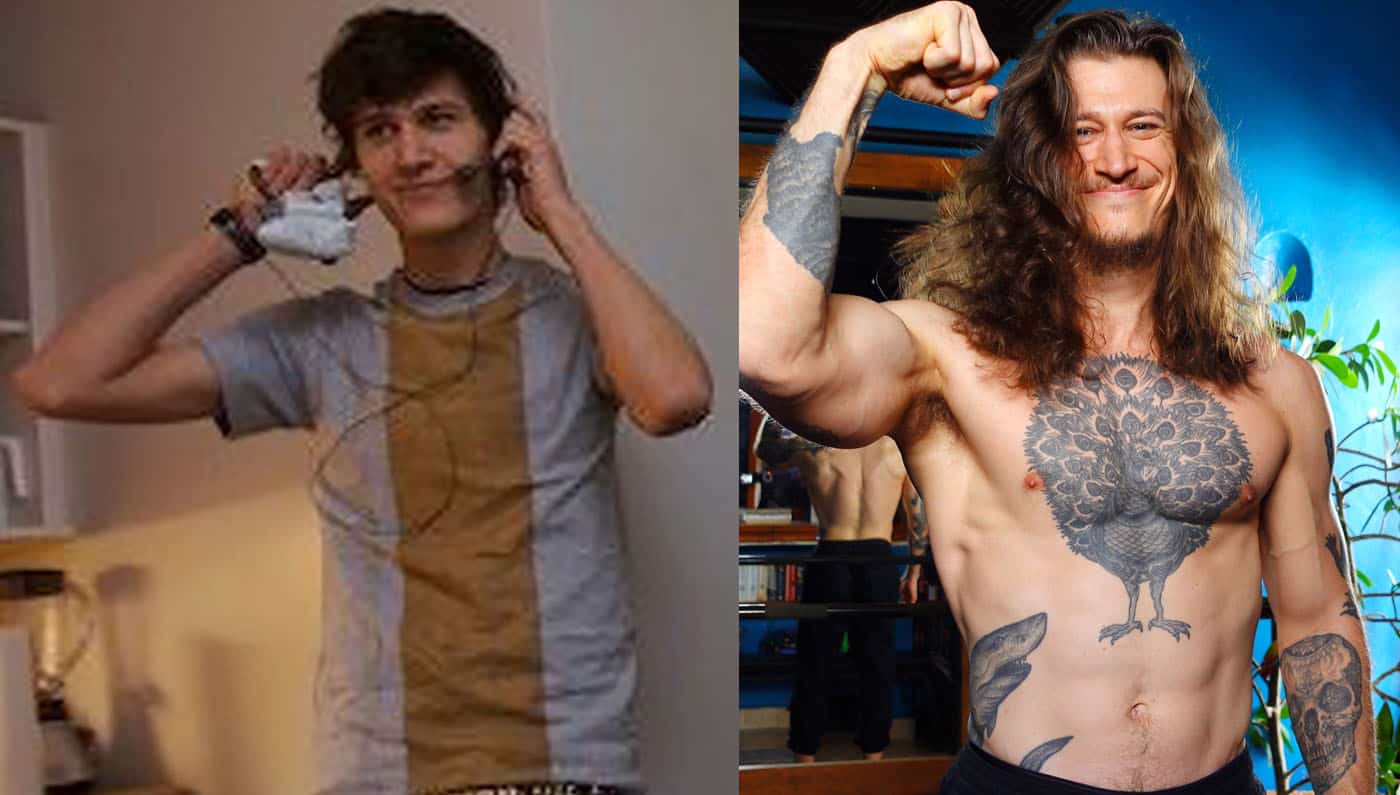
And at other times, I let myself undereat a little bit, focusing on eating well, but not worrying about a bit of weight loss. My muscle is happy to stick around, and it burns off any fat I gained while bulking. Lately, I’ve started using these periods of weight loss to work on my cardio, trying to set new PRs on the jogging path. That’s how I’ve gradually gained 70 pounds over the past decade.
Alright, that’s it for now. Our new health and aesthetics program is on sale for the next few days. We’ll give you a personal assessment, show you how to build muscle and burn fat in a healthy and sustainable way, and track your progress with you, guiding you through any problems you run into.

Or, if you want a more foundational approach, check out our Bony to Beastly Program. It, too, includes personal support. We’ll guide you through your full transformation.

